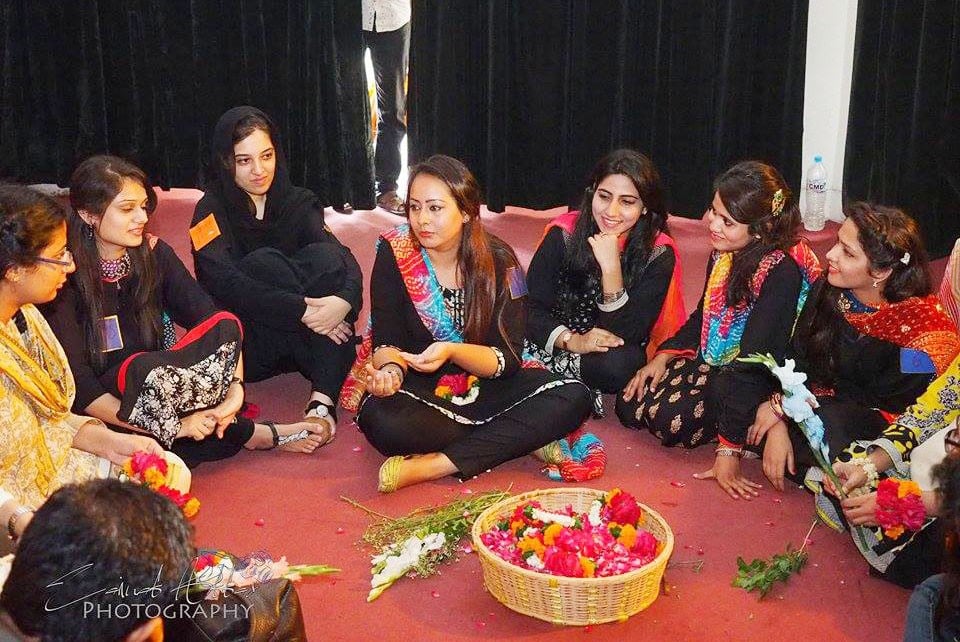
Kinnaird College’s theatrical collaboration with Arizona State University, aptly titled Lahore in Miniature, encapsulated stories of individuals living in the city

Can the ‘City of Gardens’ be encapsulated and presented through individual stories of the people living within it? Kinnaird College for Women, in collaboration with Arizona State University, tried to do just that and more, recently, in its theatrical presentation, aptly titled Lahore in Miniature.
Staged at the college’s Hladia Hall, the play was an attempt at ‘experiencing’ the city through the technique of immersive theatre.
Our region’s mainstream theatre repertoire separates the audience from the performers by a ‘fourth wall.’ But Lahore in Miniature cleaved that wall and let the audience experience storytelling where sometimes they were the listeners while at others the tellers.
In a time span of mere three weeks, the students of MPhil English Literature from Kinnaird devised three scripts, each distinctly focusing on three of the primary senses of sight, sound and smell. Each story within the three categories was the performers’ own yet centred on some aspect of Lahore. In addition, epic folk tales of the region, such as ‘Heer Ranjha’ and ‘Sohni Mahiwal,’ were interwoven into the collective narrative of the performance.
The audience was sorted into groups by coloured tags. Upon entering the hall, the audience was greeted by two air hostesses informing them that they had boarded a plane that would journey across Lahore. Soon the audience was taken through a series of three spaces, all specifically allocated within the premises of Hladia Hall.
The stage was utilised for the projection of videos on multiple vertical sheets as the performers from KC told their individual tales of sight. A performer told her story about her childhood when she used to watch the TV play Ainak Wala Jinn. Her tale was supported by visuals of the play that were projected onto the screens, in addition to other performers suddenly donning the roles of Bil Batori and Zakuta Jin.
The tales were varied but all were accompanied by visuals that lent another dimension to the narrative. A performer talked about her love for lassi while another about her childhood memories of her mother using a broomstick and producing the sound of ‘swish swash’ that was still fresh in her mind.
A side of the middle area of the hall was designated for telling stories of smell. Encircled, the crowds sat there with the storytellers (the performers). Each of them told their fondest or dismal stories related to flowers (the theme for smell).
Then the sound of flute echoed, followed by the story of Heer Ranjha and Mirza Sahiban, both performed in the middle of the hall.
Again, the audience was ushered in another space in the hall where they sat and listened to the stories on the theme of sound. A girl recounted how she had once dropped a plate of biryani incurring the wrath of her mother. So now whenever she saw a plate of biryani it reminded her of that insult.
After this, the story of Sohni Mahiwal started. As the story came to an end, the audience was again asked to move, this time towards the middle of the hall. Everyone, under a single sheet of cloth, did the traditional ‘luddi’ dance and then was ushered outside.
Directed by Erika Hughes and Boyd Branch from Arizona State University and Asma Niaz from Kinnaird College for Women, the performance was a unique take on ethnographic theatre, a type that is centered on anthropology.
Like a miniature painting that uses small strokes to convey a single, holistic idea on a large canvas, the play dramaturgically used myriad stories to tell a collective narrative about the city of Lahore.
Of course, the performance could have been better had it been managed more tightly. The voice throw of most performers was weak. When so much is happening within a single area, it is inevitably difficult to keep the concentration of the audience. Had the performance been done at a bigger space this could have been helped.
When the proverbial fourth wall in theatre breaks, it becomes a daunting task for the performers to act and also interact with the audience. In this situation, the performers took the challenge head-on for which they should be commended.
Boyd Branch, with his team members Syeda Asna Batool and Faryal Dar of Kinnaird College, did a fair job of finding relevant footage for the projections. For instance, in the story of Sohni Mahiwal, Mawra Ahmad lent her beautiful vocals to ‘Akhiyan nu rehn de’ and ‘Lambi judai’. Ansa Jamil was brilliant as Bil Batori.
Talking to TNS after the show, Erika Hughes pointed out that the biggest challenge for her was the time constraint since she and Branch had landed in Lahore only three weeks back.
Pulling a huge production unit together was another challenge, as they both had come to the city for the first time. But the three directors started working on the project immediately. They listened to the stories of the students of MPhil English Literature.
Saleha Malik, one of the performers of the play, and a student of the college, said that traditionally, "in a theatre play, the director’s input in 70 percent while the rest is the actor’s job. But in this case, the reverse was happening."
A city can be best represented by the people living within it. And what better way to show what the city is than to let the stories of its citizens unfold.